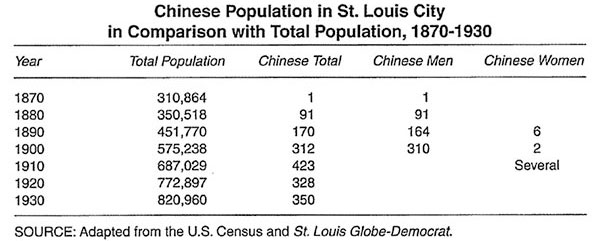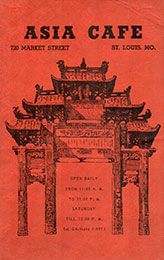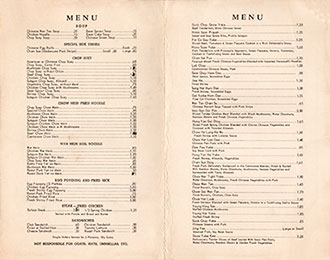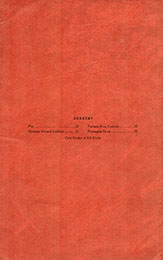|

Chinatown
In the last decades of the nineteenth century,
St. Louis was a city of rich ethnic diversity. Immigrants from other
continents composed one third of the city’s population. St. Louis
was the fourth largest city in the United States at the time.
It is during this period that Chinese started
arriving in St. Louis. The first recorded Chinese immigrant was Alla
Lee, who arrived in 1857 and opened a small shop on North Tenth
Street selling tea and coffee. By the end of the nineteenth century,
the Chinese community in St. Louis had grown to about three hundred.
The earliest Chinese settlers in St. Louis
congregated in an area between Seventh, Eighth, Market and Walnut
Streets, which became the Chinatown of St. Louis, more commonly
known as Hop Alley. The name was widely used to represent the
district where Chinese hand laundries, merchandise stores, grocery
stores, herb shops and restaurants were located.
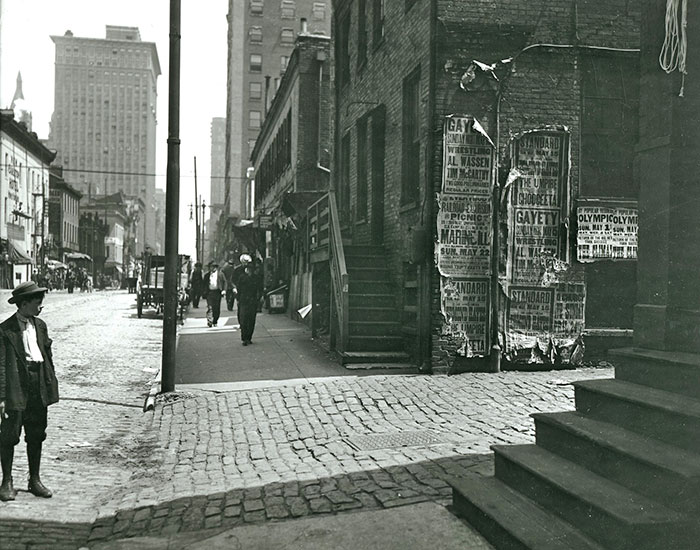 |
| Hop
Alley looking north on Eighth Street between Walnut and
Market Streets, 1910 |
Chinese restaurants were initially started to
satisfy the needs of Chinese bachelors. They served
authentic Chinese dishes that appealed mainly to
Chinese.
In January of 1894, Theodore Dreiser, then a 23
year-old reporter for the St. Louis Republic, visited the Kee
Hong Kee restaurant at 19 South Eighth Street while researching a
story about the Chinese in St. Louis.
The first dish set on
the bare table was no longer than a silver dollar and contained
a tiny dab of mustard in a spoonful of oil. Three dishes of like
size followed, one containing pepper jam, the others meat
sauces. Tea was served in bowls, and was delicious. The duck,
likewise the chicken, was halved, then sliced crosswise after
the manner of bologna sausage, and served on round decorated
plates. One bowl of chicken soup comprised the same order for
two, which was served with dainty little spoons of chinaware,
decorated in unmistakable heathen design. Rice, steaming hot,
was brought in bowls, half platter. Around the platter-like edge
were carefully placed bits of something which looked like wet
piecrust and tasted like smoked fish. The way they stuck out
around the edges suggested decoration of lettuce, parsley and
watercress. The arrangement of the whole affair inspired visions
of hot salad. Celery, giblets, onions, seaweed that looked like
dulse, and some peculiar and totally foreign grains resembling
barley, went to make up this steaming-hot mass.
St. Louis Republic, Jan 14, 1894
As Chinese restaurateurs expanded
their menus, chop suey shops opened in Hop Alley. Chop suey could be
easily prepared and was widely accepted by non-Chinese patrons as
representative of Chinese food.
The origin of chop suey is widely debated. St
Louisan Emily Hahn presented one popular theory in her book on
Chinese cooking.
Two dishes that
Westerners do know and repeatedly order are chop suey and chow
mein. This is a great pity, for while chow mein can be good
enough, there is little one can say in favor of chop suey, a
dish unknown in China. One explanation of its origin is that the
dish was born when the famous 19th Century diplomat Li Hung
Chang, traveling in the West as the Chinese emperor's emissary,
got indigestion from rich foreign food at banquets he had to
attend. He had so agonizing an attack of biliousness following a
hard week's banqueting in the United States that his aide Lo
Feng-luh suggested a bland diet. Between them the gentlemen
thought up the plainest possible dish – a concoction of celery
and other vegetables sautéed with a little pork. Thus was chop
suey born. The
other standby of Chinese restaurants in the United States, chow
mein, is something else again. It had an honorable origin in
China, where it is often eaten as a snack or light meal. When
well prepared, it can be very good. (I still remember the
chicken chow mein I ate on my first date, hundreds of years ago
in St. Louis, in a Chinese restaurant where we were awed and
delighted by lovely hanging lamps with red silk panels that gave
out little illumination, and a romantic table of black wood
inlaid with bits of abalone shell or possibly genuine
mother-of-pearl. All the mysterious East was ours in Missouri,
and chow mein too.)
The Cooking of China, Time-Life
Books, 1968
Orient Restaurant
Jo Lin was born in San Francisco in 1883. He
arrived in St. Louis in 1906 with no family and little money. By
1916, he owned the Orient Chop Suey Restaurant at 419 North 6th
Street, over the Strand Theater.
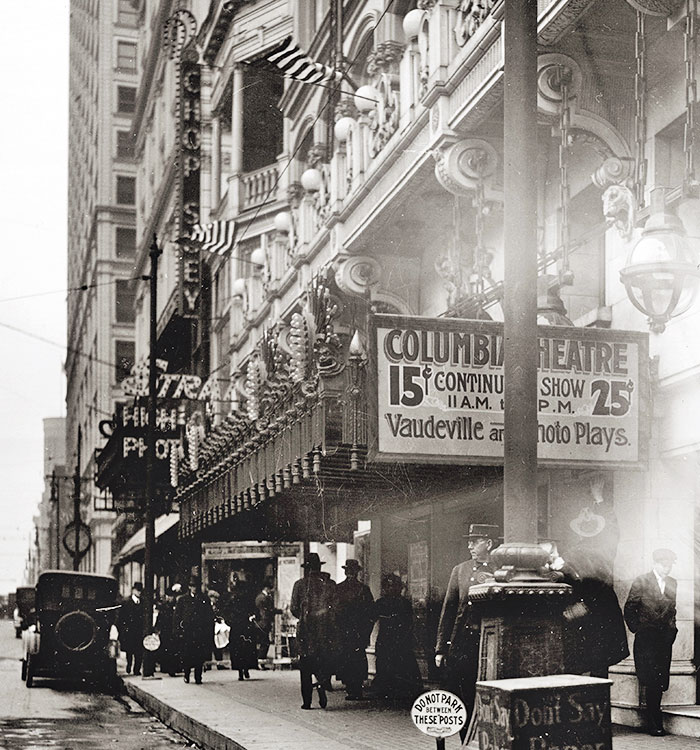 |
| Orient
Chop Suey Restaurant, 419 North 6th Street, 1916 |
Advertising Men – You
Are Invited to Visit The Orient Chop Suey
More than 400 Chinese and American
dishes prepared by the most famous Chinese chefs in the country.
Enjoy these good things to eat amid the luxurious surroundings
and quaint Chinese decorations. We especially cater to ladies’
afternoon tea parties in our richly designed tea room. In our
specially arranged banquet room we are prepared to take care of
small banquets.
The St. Louis Star, Jun 7, 1917
Joe Lin was forced to move his restaurant when
he lost the lease on the space above the Strand Theater. On March
19, 1926, he reopened the Orient at 414 North 7th Street.
The opening today of
the new $40,000 Orient chop suey restaurant, 414 North Seventh
street, is the realization of success for Joe Lin.
Lin arrived in St. Louis in 1906 with
65 cents in his pocket and only one acquaintance. Today he is
opening one of the largest chop suey restaurants in the central
west. Joe admits he is wealthy, but he says he does not know
just how much he is worth. He says:
"To succeed in any business, but
especially the restaurant business, you must cater to all the
people, regardless of who they are."
The St. Louis Star, Mar 19, 1926
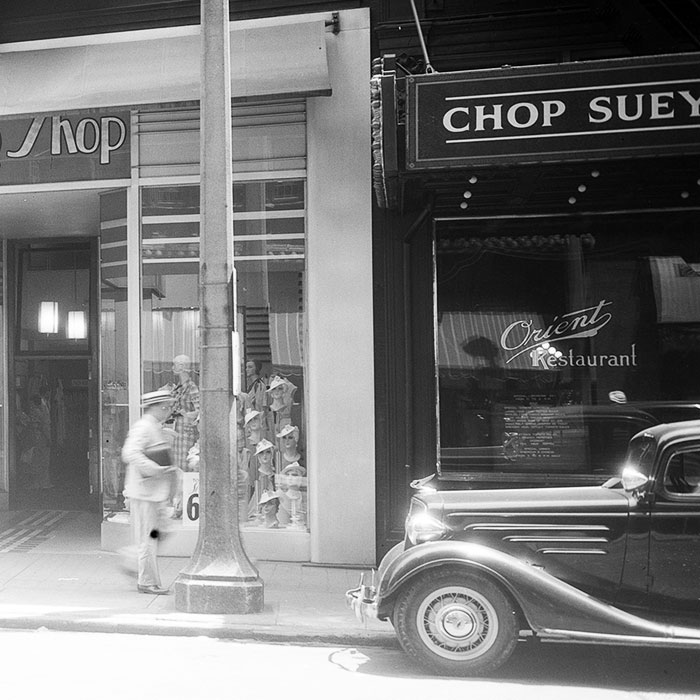 |
| Orient
Restaurant, 414 North 7th Street, 1935 |
On February 4, 1929, Eugene O'Neill's
Strange Interlude opened at the American Theater. The nine act
play ran from 5:30 p.m. until 11:00 p.m., with a dinner intermission
at 7:40, following the fifth act. Theatergoers could walk three
blocks north on Seventh Street to the Orient for a bite to eat and
then return to the American at 9:00 for the play's final four acts.
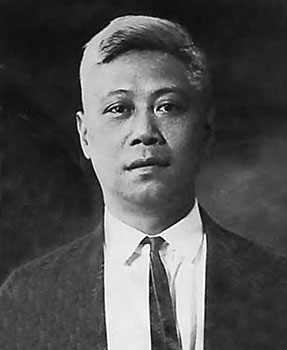 |
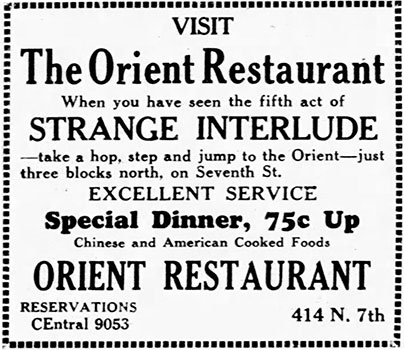 |
| Joe
Lin, 1924 |
St.
Louis Post-Dispatch, Feb 5, 1929 |
The Orient offered an
exotic dining experience, complete with hanging red lanterns and
steaming pots of Darjeeling tea. The chicken
and
pork chow mein were customer favorites. The chow mein wasn't
prepared ahead of time like most other restaurants. The vegetables
were cut up and kept crisp and cold, then cooked with the meat when
ordered.
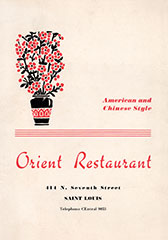 |
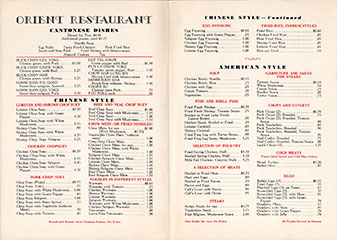 |
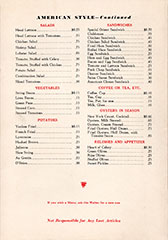 |
1940s Orient Restaurant
Menu
(click image to enlarge) |
Joe Lin held the honorary title of Mayor of
Chinatown. He was the president of the On Leong Merchants Association, the dominant community organization
in St. Louis Chinatown, serving as an unofficial local government
for Chinese immigrants. Always neatly dressed and dignified, he was
a familiar figure in St. Louis courts, where he frequently served as
an interpreter in cases involving other Chinese.
Joe Lin died on December 14, 1947 of a brain
tumor. He was 64 years old. His funeral procession included a
30-piece band and 46 limousines. Chinese leaders from 28 cities
attended the service.
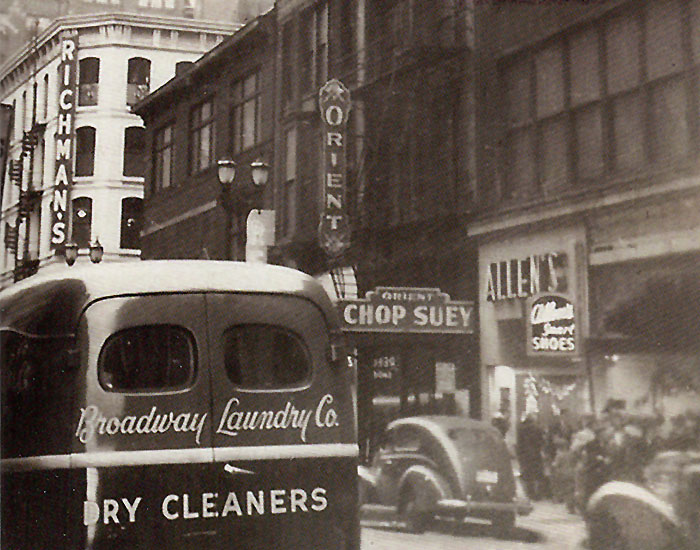 |
| Orient
Restaurant, 414 North 7th Street, late 1940s |
In early 1953, the Orient moved one block north
and across the street to 505 North Seventh in the St. Charles
building. The restaurant's ownership had passed on to Mark Raymond,
David Wai Foon Lee and Eng Mow.
The Orient continued serving chop suey and chow
mein until it closed in late December of 1967.
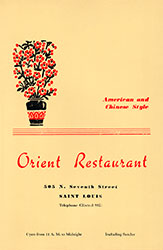 |
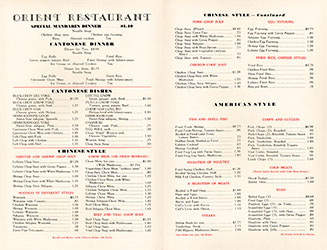 |
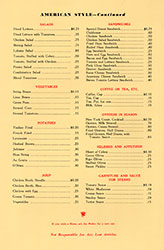 |
1950s Orient Restaurant
Menu
(click image to enlarge) |
Asia Cafe
Gee Leong was born in China in 1870 and
immigrated to the United States in 1890. By 1918, he was living in
St. Louis and had opened The New Republic Chinese restaurant at 825A
Locust.
Gee Leong became president of the On Leong
Merchants Association and assumed the title of Mayor of Chinatown.
In 1924, he married 19 year-old Chin Shee, who had immigrated to St.
Louis from China. Their three children were all born in Hop Alley –
Wing in 1924, Quong in 1928 and Annie in 1934.
On October 1, 1932, Gee Leong opened the Asia
Restaurant at 712-714-716 Market Street, in the same building which
housed the On Leong Merchants Association on the second floor. The
restaurant would come to be known at the Asia Cafe, with its address
morphing to 720 Market.
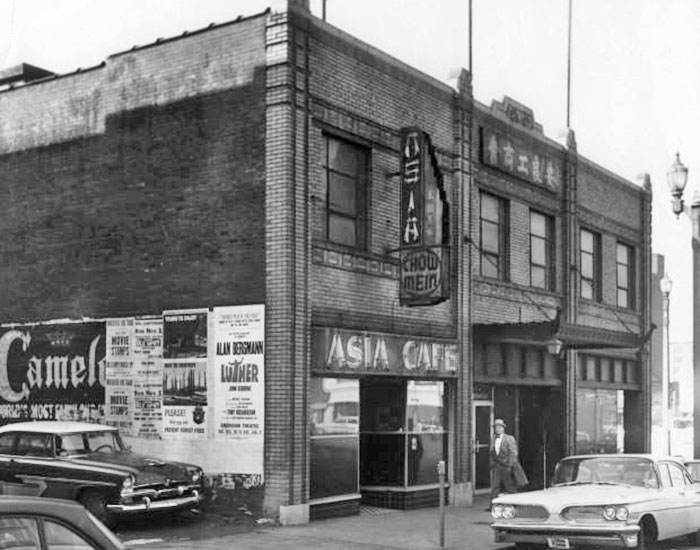 |
| Asia
Cafe, 720 Market Street |
For real Chinese
dishes, Asia restaurant, at 712 1/2 Market street. Up a long
flight of stairs and nothing to see when you get there, unless
there are Chinese in the back room using chopsticks. Food is
excellent and inexpensive. If you feel you really ought to try
bird's nest soup or shark fins, order a day or so ahead of time.
Authentic chow mein, chop suey, eggs fooyoung, with rice, tea,
fruit preserves in honey and almond cakes, can be had without
notice. Make friends with Nin Young, the proprietor, and he'll
take you back stage to show you how he sprouts his own beans,
and prepares the odd ingredients like water chestnuts and dried
mushrooms. No spirits available.
St. Louis Post-Dispatch, Jan 17,
1937
Nin Young immigrated to San Francisco from
China in 1917 and came to St. Louis in 1919. He had worked for
Gee Leong at The New Republic and followed him to the Asia.
Gee Leong died in July of 1937 at the age of
67. Nin Young purchased the Asia and became a step-father to Wing, Quong and Annie Leong.
Chin Shee continued to work at the restaurant and lived in the rear
of the building with her children.
Annie Leong recalled her life in the restaurant
in the 1930s and 1940s.
The whole family
worked. If you didn’t get paid, it was okay. My mother worked in
the dining room and kitchen of the restaurant. My dad worked as
a chef. During the depression era, they survived and they made a
living out of it. . . . We worked seven days a week, from eleven
o’clock in the morning to midnight . . . . We [she and her
brothers] did everything. We wrapped wontons, we took care of
the dining room area and we set up restaurant. Then if they
needed you, you could cook too. So we did whatever was needed.
It was just natural, and you just did it. We were going to
school besides that and we had to do our homework too. You were
studying between customers. After school, you would study, and
it would get busy during dinner hours, and you took care of all
the customers. In between, you would study a little, and then
you took care of customers. After the dinner rush was over,
maybe about eight o’clock or something, you could really have
more time to study. I guess that was something you never thought
about and that was something you did.
The Asia Cafe was a favorite meeting place for
the Chinese community. Patrons met to talk in their native
language, to read the two daily Chinese language newspapers and to
play mahjong.
Annie Leong became manager of the restaurant,
along with her step-father.
Many politicians and
show people – from the American Theatre and even the Grand – ate
with us, Sometimes when a judge came for lunch, the lawyers in
the room would stand up and say, "Your honor!"
We had "stir fries" back then, by the
way. It took most Americans many years to discover them.
* *
* * *
As buildings in the Chinatown neighborhood were
sold for parking lots, families moved out. While the older
generation of Chinese residents worked in restaurants and laundries,
the younger generation had educational opportunities and became
engineers, accountants and chemists.
In 1965 it was announced that the building
which housed the On Leong Merchants Association and Annie Leong's
Asia Cafe would be leveled to make way for a commercial development
associated with the new downtown sports stadium.
I was born in this
building. It's home and I don't want to leave. I think some of
the older Chinese people will be lost when they're forced to
move out of this block. I guess I feel like a landmark myself.
This neighborhood with its
closely-knit, old-fashioned Chinese families built character.
Juvenile delinquency didn't exist in Chinatown.
Nin Young planned to retire and Annie Leong was
hesitant to run the restaurant on her own.
These days it's very
hard to get an authentic Chinese cook. I can cook, but I'm slow.
If a good Chinese cook could be persuaded to come here, he'd
probably come from San Francisco or New York, and he wouldn't be
happy because we don't have the Chinese population here that
they do in those towns. He'd get lonely.
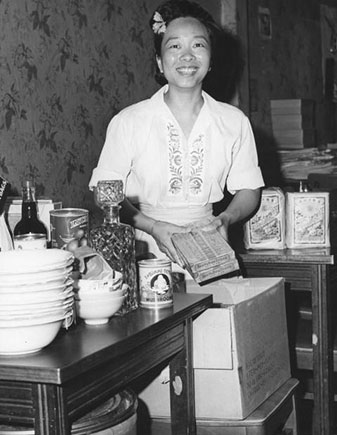 |
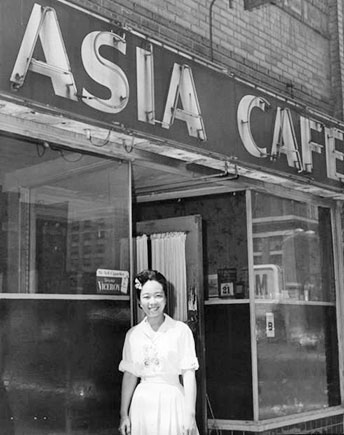 |
|
Annie Leong, Asia Cafe,
1965 |
The Asia Cafe closed on August 1, 1965. The
restaurant was the last business standing in Hop Alley. The land
between Seventh, Eighth, Market and Walnut Streets would be cleared
to make way for the General American Life building.
The last vestige of Chinatown had disappeared.
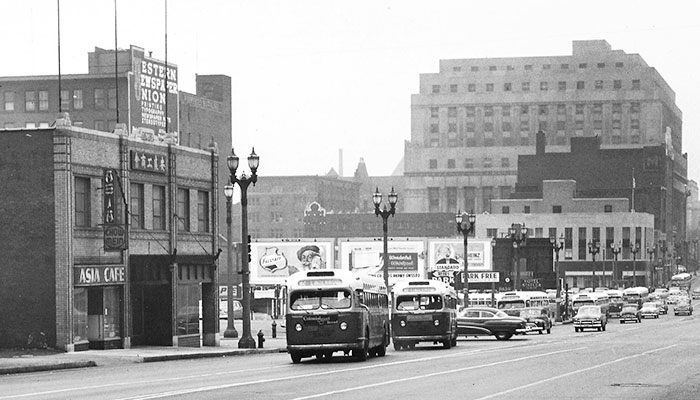 |
Looking
west on Market Street from Seventh Street, 1965
|
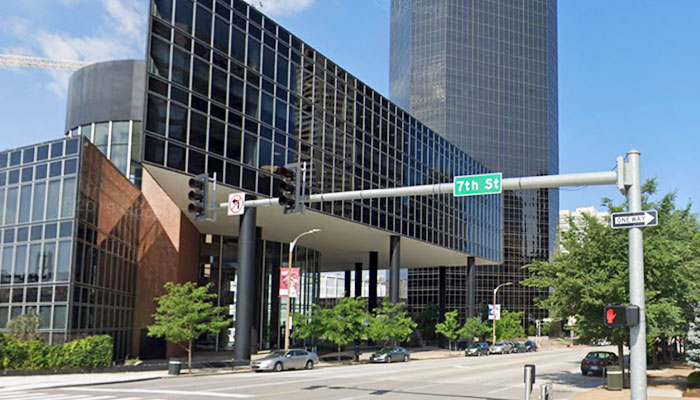 |
| Looking
west on Market Street from Seventh Street, 2019 |
Copyright © 2023 LostTables.com
Lost TablesTM
is a trademark of LostTables.com. All rights reserved. |


